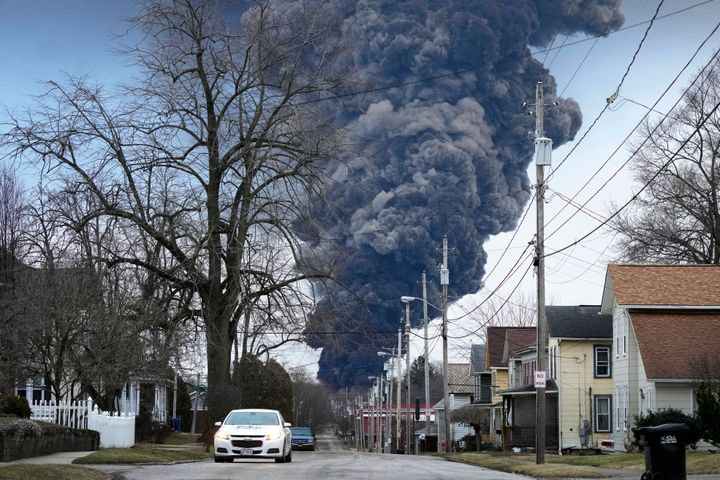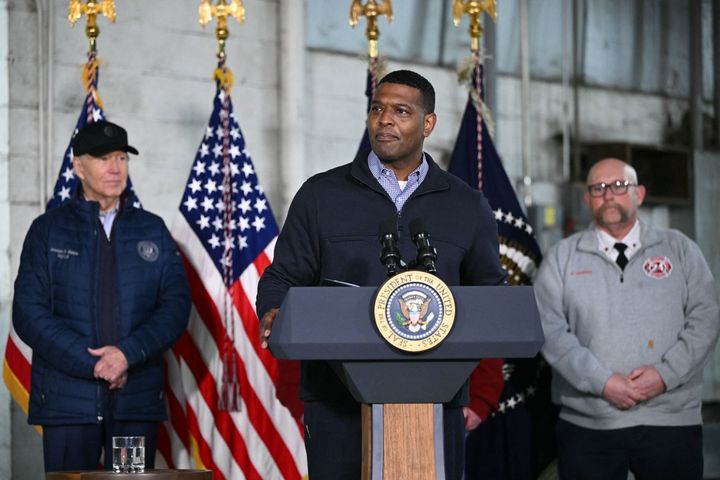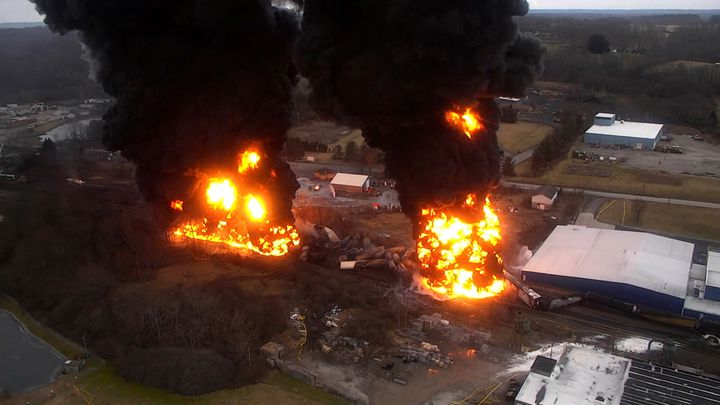Ex-EPA Official Says ‘Bombshell’ Memo Raises Major Questions About Ohio Chemical Burn
Three days after a Norfolk Southern train loaded with toxic chemicals careened off the tracks in East Palestine, Ohio, town fire chief Keith Drabick gave the rail giant the green light to intentionally vent and burn five tanker cars full of vinyl chloride, a cancer-causing chemical used to make plastic.
That highly controversial move, which Norfolk Southern and others involved in the response said was necessary to prevent a potentially catastrophic explosion, released massive black plumes of noxious smoke.
Advertisement
In the year since, Norfolk Southern, the Environmental Protection Agency and Ohio EPA, a state agency, have repeatedly described the dramatic scene that unfolded that day as a “controlled burn” or “controlled release” — language that would suggest the incineration was contained, limited and safe.
But many questions remain unanswered about the burn event, including how it will impact long-term public health, the extent to which those behind it considered alternatives and what, if anything, EPA did to try to prevent toxic chemicals from being spewed into the environment.
Kevin Garrahan, a retired EPA official of nearly 40 years, has struggled to make sense of his former agency adopting the “controlled” label. In the weeks after the derailment, he reached out to current EPA staffers and independent scientists to voice his concerns about the potential release of dioxins and other highly toxic chemicals, and to try to understand how EPA could have let the burn happen.
“This just seems like an incredibly stupid and reckless decision,” Garrahan wrote to his former colleague three weeks after the chemical burn, in an email exchange he shared with HuffPost. “Am I missing something?”
Advertisement
Later that day, Garrahan received what he described as a “cryptic” response. The EPA official he was emailing with mentioned the ongoing problem of “OB/OD,” or open burning and open detonation of hazardous materials, and said he shared Garrahan’s concerns about dioxins and the federal agency’s response.
“Our EPA and Ohio EPA at their best!!” the current EPA official remarked sarcastically.
Garrahan, whose work at EPA included environmental risk assessment and hazardous waste cleanup, pressed his former colleague about the burn and EPA’s public pronouncements that East Palestine was safe. He never heard back.
Dioxins are a family of extremely toxic compounds that take a long time to break down in the environment and can accumulate in the food chain. They are known to form when chlorinated chemicals like vinyl chloride combust. EPA has acknowledged that it never considered monitoring directly for dioxins during the burn event, and internal agency communications show that certain relevant EPA experts, including a top dioxin expert, were not consulted until a month after the derailment, HuffPost previously reported.
The open burning of toxic chemicals has been banned in the United States since 1980 due to risks to human health and the environment. The only exception is for explosives, primarily military munitions, that cannot otherwise be safely disposed of.
Garrahan referred HuffPost to an EPA memo, published in June 2022, outlining all the restrictions on what can legally be burned and how. The memo makes it clear, he said, that the so-called “controlled burn” of vinyl chloride in East Palestine meets the definition of an open burn that shouldn’t have been allowed under EPA’s own rules.
Advertisement
Garrahan views the EPA memo as a “bombshell” that raises questions about the burn event and EPA’s disaster response.
“If somebody is doing something that is illegal and they know about it, they have a duty to say, ‘Hey, you are purposefully violating a major EPA regulation,’” Garrahan said. “It’s inconceivable that there wouldn’t have been someone from the enforcement office, or general counsel, saying, ‘Oh, Norfolk Southern wants to do an uncontrolled burn — that’s illegal, you cannot do that. Or if you do, you’ve got to go through these hoops.’”

via Associated Press
The burn itself was a crude process in which emergency responders blasted holes in the five tanker cars, drained the vinyl chloride into pits in the ground and set it on fire using flares. Drabick, who as incident commander made the final call, told federal investigators at the National Transportation Safety Board that Norfolk Southern and its contractors presented intentional burning as the only viable and safe option due to the risk of an explosion, and gave him just 13 minutes to make the decision — a request that he said left him “blindsided.”
Ohio Gov. Mike DeWine (R) and Norfolk Southern have defended the vinyl chloride burn, citing the risk of tanker cars exploding. DeWine’s press secretary, Dan Tierney, called it “the best of two bad options.”
Advertisement
Other local officials and environmental experts, however, have questioned the decision and the motivations behind it. Norfolk Southern reopened the rail line the day after torching more than 1 million pounds of vinyl chloride.
During a Senate hearing Wednesday, Jennifer Homendy, the chair of NTSB, testified that the vent and burn operation was not necessary, as there was no sign of a chemical reaction, known as polymerization, that would cause tank cars to explode.
“In order for polymerization to occur, which was Norfolk Southern and their contractors’ justification for the vent and burn, you would have to have rapidly increasing temperatures and some sort of infusion of oxygen, neither of which occurred,” she said.
Homendy added that Norfolk Southern’s contractors “lacked the scientific background” to support the burn decision, and that another option was available: “Let [the tank car] cool down.”
Sen. J.D. Vance (R-Ohio) called Homendy’s findings “extraordinary” and “troubling.”
“This town very well may have been poisoned to facilitate the rapid movement of freight,” he said at the hearing.
Advertisement
Garrahan, who now teaches at George Washington University, argues EPA should have used the 2022 guidance, which had been published just eight months before the derailment, to object to the railroad’s plan to vent and burn hazardous chemicals. It is “unfathomable” to think that EPA may have stood idly by while a potentially illegal open burn was conducted, he said, adding that he has had many sleepless nights ruminating on how the incident might have harmed human health and the environment.
As the memo notes, open burning is defined as “the combustion of any material without the following characteristics: (1) control of combustion air to maintain adequate temperature for efficient combustion; (2) containment of the combustion reaction in an enclosed device to provide sufficient residence time and mixing for complete combustion; and (3) control of emission of the gaseous combustion products.”
The 2022 guidance was written to spell out when local EPA officials can issue permits for pre-planned burning of waste explosives — not emergencies like the chemical disaster in East Palestine. Vinyl chloride is not classified as a waste explosive under the Resource Conservation and Recovery Act, or RCRA, the 1976 law that regulates the disposal of hazardous waste.
Still, the memo was meant to “communicat[e] the existing requirements under RCRA that prohibit open burning, including open detonation, of hazardous waste” and contains broader language about the risks of burning any such material. It notes that EPA concluded in 1987 that “open burning of nonexplosive waste could not be conducted in a manner that was protective of human health and the environment.”
Advertisement
“OB/OD is generally the least environmentally preferred treatment technology and, consistent with existing requirements, should only be available where there are no safe modes of treatment.”
– 2022 EPA guidance on open burning and open detonation
The memo states that open burning of hazardous materials should be a last resort, that costs should not be a consideration when determining if safe alternatives are available, and that extensive chemical monitoring is required during any open burn. The agency cited two recent reports that outline many safer ways to get rid of noxious waste.
Open burning “is generally the least environmentally preferred treatment technology and, consistent with existing requirements, should only be available where there are no safe modes of treatment,” the memo reads.
More than a year after the fiery train derailment, EPA “has taken no position regarding whether or not the burn event in East Palestine was an ‘open burn’ as defined by USEPA regulations,” agency spokesperson Kirstin Safakas told HuffPost. Safakas dismissed the idea that the 2022 EPA memo applies to the East Palestine burn event, noting that the guidance is specific to waste explosives, which were not involved in the derailment.
EPA did not respond to questions about whether the agency ever objected to Norfolk Southern’s planned burn, if it discussed or considered its 2022 memo prior to the operation, and what EPA protocols guided the agency’s response.
Advertisement
Garrahan said it would be tough for EPA to argue that the 2022 memo doesn’t apply to the Ohio disaster. He pointed out that when it comes to long-term cleanup of toxic and hazardous Superfund sites, EPA is not required to obtain permits for on-site remediation work, but still must “follow the spirit of the law” by meeting “the functional equivalent” of those rules to ensure human health and the environment are protected.
Likewise, for open chemical burns, even the rare situations where a permit might not be required, the parties conducting the burning should still have to comply with relevant requirements to safeguard the environment and the public, Garrahan said. His concern is that few if any safety controls were in place during the vinyl chloride burn.
Stephen Lester, a toxicologist and the science director for the Center for Health, Environment and Justice, shares Garrahan’s view that the EPA memo makes clear that the vinyl chloride burn violated EPA regulations for open burning of hazardous waste. He said the EPA had a duty to step in and stop it.
“They chose not to,” Lester said. “I’ve heard everything from, ‘Well, we were in the room but nobody asked our opinion,’ to ‘We were in the room but we just didn’t say anything.’ It’s like, you’re in the room. You have the authority, you have the right, you have the responsibility to say something.”
Judith Enck, a former EPA regional administrator, has a slightly different interpretation of the 2022 EPA memo on open burning: She said she doesn’t think it applies to an emergency situation like East Palestine, but she acknowledged it includes important principles that are relevant, namely that alternatives to open burning must be evaluated. Enck noted that EPA has specific protocols for responding to a myriad of environmental disasters, including derailments involving hazardous chemicals.
Advertisement
“I think what happened [in East Palestine] is EPA deferred too much to the state of Ohio, and Gov. DeWine deferred too much to Norfolk Southern because their priority was getting that busy rail corridor opened up as quickly as possible,” Enck said.

MANDEL NGAN via Getty Images
EPA has provided conflicting messages about the role it played in the decision-making process and, for the most part, has continued to describe the burn event as “controlled.”
At a press conference shortly after the derailment, EPA Administrator Michael Regan said the vent and burn decision was made “in consultation with how EPA could respond to that in terms of monitoring the air and the impact.” An EPA spokesperson, however, told HuffPost that the agency was present during ad hoc meetings leading up to the burn, but did not order and was not consulted about the decision.
EPA’s website on the East Palestine response repeatedly describes the operation as a “controlled burn,” and Regan used that language several times during a press gaggle while he and President Joe Biden were en route to East Palestine to mark the one-year anniversary of the derailment last month.
Advertisement
“I could understand if they referred to it as an ‘emergency burn,’ but calling it a ‘controlled [burn]’ is the opposite of what happened and sure makes it look like they were intentionally trying to mislead the public,” Garrahan said.
In a video obtained by independent media outlet Status Coup News in June, Mark Durno, EPA’s onsite coordinator for the response in East Palestine, acknowledged that the ignition of vinyl chloride could be considered an open burn, but added that “in an emergency situation, it is what it is.” He went on to note that EPA itself is exempt from open burn regulations during emergency situations, but stressed that Norfolk Southern is not and there “could be significant fines and penalties levied based on their actions.”
The EPA and Department of Justice filed a civil lawsuit against Norfolk Southern in June, alleging that the company violated the Clean Water Act when it released pollutants into the environment.
EPA did not address HuffPost’s specific question about why the agency has repeatedly called the burn event “controlled.” However, a spokesperson told HuffPost that the agency was not the first to label the event a “controlled burn,” that the railroad and other members of the unified command team began using that language early on in the response, and that EPA’s role during the burn was to “coordinate and conduct air monitoring from outside the evacuation area.”
The agency directed HuffPost to the Ohio EPA for additional information about the origin of the “controlled” terminology.
Advertisement

via Associated Press
Bryant Somerville, a spokesperson for Ohio EPA, told HuffPost that the agency and other members of the incident command team were presented with “no feasible option” that did not include releasing vinyl chloride. Norfolk Southern had “concluded a catastrophic explosion was inevitable unless the contents were released to reduce pressure.”
“The burn portion was advised because the chemical byproducts of a burn were advised to be less harmful than the chemicals in their current state,” Somerville said. “Due to the inevitable explosion absent intervention, not conducting a release was not an option provided to command. Command agreed with the decision. While neither the Governor, Ohio EPA, nor the Ohio National Guard were final command decision makers, all agreed with the decision as the safest possible.”
Asked whether calling the burn “controlled” misleadingly suggests that the environmental impacts were contained, EPA directed HuffPost to a Department of Transportation handbook on the emergency vent and burn procedure used in East Palestine. That document, published in 1994, provides detailed information about when and how to use the method, but little about potential environmental risks. Much like the EPA memo on open burning nearly three decades later, the DOT document notes that venting and burning hazardous materials should only occur when no other option exists.
“Due to the inherent risks involved with this procedure, it must be used only as a last resort, after all other methods of field product removal have been considered and rejected,” the DOT handbook reads.
Advertisement
EPA previously told HuffPost it was caught off guard by the amount of vinyl chloride that Norfolk Southern ultimately burned. Initially, the rail company was planning to burn one tanker car, but that number jumped to five the morning of the burn — a sudden change in plans that Durno said limited EPA’s ability to mobilize resources. Eric Brewer, the director of emergency services for a neighboring county in Pennsylvania, called the choice to burn more cars “jaw-dropping.”
Two representatives of OxyVinyls, the company that manufactured the vinyl chloride onboard the train, have cast doubt on whether an explosion really was imminent. At a NTSB hearing in June, they told investigators that they never saw signs of a chemical reaction that would cause the tank cars to explode, and repeatedly relayed that view to Norfolk Southern.
Enck, the former EPA regional administrator, called the intentional burning of vinyl chloride an “unprecedented” action that should never have happened. She recalled a similar derailment of a train hauling vinyl chloride in Paulsboro, New Jersey, in 2012, when she was still at EPA. In that case, officials sealed off the derailed tanker cars and used vacuum trucks to remove the hazardous gas and haul it to a disposal facility, she said.
“EPA sat idly by when a major bad decision was made,” Enck said of the East Palestine response. “The big question is if there is another train derailment involving toxic chemicals — and there will be — would EPA sit idly by and allow a state and a polluter to decide to do an open burn again? Is this now their standard operating procedure? Because it didn’t used to be.”
Garrahan has mixed feelings about speaking out against his former agency. After a career in public service, he’s enjoying retirement and not looking to cause a stir.
Advertisement
“I do believe that persons having to make difficult decisions with limited information generally deserve the benefit of the doubt,” he said. “However, if those decisions seem to violate EPA’s mission and sacred trust to protect human health and the environment, then I feel a moral obligation to speak out for environmental justice.”

Comments are closed.